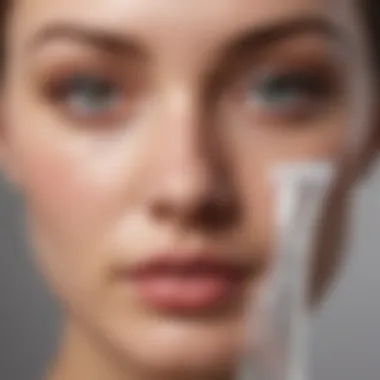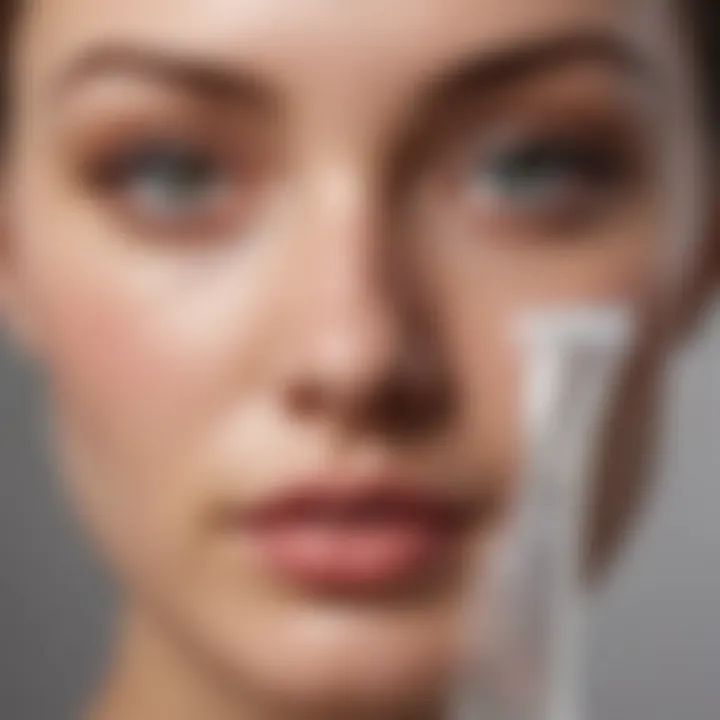Essential Facial Cleansers for Oily Skin


Intro
Navigating the world of skincare can often feel like trying to find your way through a dense fog. Oily skin presents a unique set of challenges, from unsightly shine to the occasional unwelcome breakout. The search for an effective facial cleanser tailored to meet the specific needs of oily skin is not just about keeping a fresh face; it’s about understanding the ingredients that truly work and how they interact with your skin type.
When selecting a cleanser, one must consider factors like pH balance, as this plays a crucial role in maintaining the health of your skin barrier. Using the wrong product can lead to increased oil production or irritation, which is the last thing anyone with oily skin would want. This guide aims to demystify the selection process, share insights into what ingredients to look for, and recommend products that might just be the key to achieving that sought-after, balanced complexion.
In the sections that follow, we’ll dive into the components that make a cleanser effective for oily skin, exploring everything from gentle exfoliating properties to hydrating qualities. So, whether you're wrestling with excess shine or need help figuring out what really goes into these products, we've got you covered.
Prelude to Oily Skin and Cleansing
Managing oily skin can be a real balancing act. For many, it feels as if their skin is constantly gleaming, and not in the good way. This shine often leads to discomfort and can escalate into acne and other skin troubles. Understanding oily skin and the necessity of proper cleansing routines is essential for anyone who's struggling with their complexion. Here, we'll dig deeper into why cleansing is crucial, especially for those with oily skin, to set the stage for better skin health and appearance.
Understanding Oily Skin
Oily skin develops when sebaceous (oil) glands produce an excess amount of sebum. This oil serves a protective purpose, but too much of it can lead to clogged pores and breakouts. Oily skin often results in a slick appearance, and it typically appears shiny throughout the day, especially in areas the T-zone, which includes the forehead, nose, and chin.
This oily condition can be caused by various factors including genetics, hormonal changes, and environmental influences like humidity. Many people might find themselves grappling with greasy skin during specific periods, whether it's adolescence or the hormonal fluctuations associated with menstrual cycles. Interestingly, lifestyle choices like diet and stress also play a part. It’s important to realize that oily skin isn’t a curse but rather a unique characteristic that requires specific attention in skincare routines.
The Role of Cleansing in Skincare
Cleansing is more than just a quick splash of water on your face; it's a vital step in any skincare regimen, particularly for those blessed—or burdened—with oily skin. Effective cleansing serves multiple purposes: it removes dirt, excess oil, and impurities that accumulate throughout the day. If left unattended, these buildup can clog pores, leading to acne and other skin issues.
Choosing the right cleanser can mean the difference between a calm complexion and a breakout situation. For oily skin, the goal is clear: eliminate excess oil while still maintaining necessary moisture. Using a cleanser that's tailored for oily skin not only helps to remove that overabundance of oil but also ensures that skin still remains hydrated without the greasy feel. A well-executed cleansing routine can truly elevate one’s skincare game.
"Cleansing isn’t simply about wiping the slate clean; it’s about setting the foundation for healthier skin."
In the next sections, we will explore the characteristics of an ideal facial cleanser, focusing on key ingredients and formulation types that resonate well with oily skin. Understanding these components allows individuals to make informed decisions, ensuring their skincare practices align with their specific skin needs.
Characteristics of an Ideal Facial Cleanser
When we talk about caring for oily skin, choosing the right cleanser can be a game-changer. It’s not just about washing your face; it’s about finding a product that balances your skin’s unique needs without aggravating the oil production that many individuals face. The characteristics of an ideal facial cleanser for oily skin hinge on several pivotal elements. Not only do these attributes help remove excess sebum, but they also contribute to maintaining moisture levels, providing a balanced, fresh complexion.
A good cleanser for oily skin should effectively eliminate dirt, makeup, and oil while promoting skin health. Numerous factors come into play, including ingredient composition and formulation type. The cleanser must also be gentle enough to avoid over-stripping the skin, a common pitfall for those with oily skin.
Ingredient Considerations
Salicylic Acid
Salicylic acid is renowned for its ability to penetrate oily skin. This beta hydroxy acid (BHA) works by exfoliating inside the pores, helping to clear congestion. Its oil-soluble characteristic means it can attach to excess oil, breaking down the build-up that often leads to breakouts.
- Key Characteristic: Salicylic acid is widely recognized for its acne-fighting properties.
- Why It’s Beneficial: It helps to reduce inflammation and prevent future breakouts, making it an excellent choice for oily skin.
- Unique Feature: It offers both exfoliation and anti-inflammatory benefits, promoting a clearer complexion.
- Advantages/Disadvantages: The downside is that it can be drying; hence, those using it should monitor their skin’s response to avoid irritation.
Benzoyl Peroxide
Another popular component is benzoyl peroxide, known for its strong antibacterial effects against acne-causing bacteria. It works uniquely by introducing oxygen into the pores, which bacteria cannot survive.
- Key Characteristic: Benzoyl peroxide is a potent anti-acne ingredient.
- Why It’s Beneficial: It helps reduce the number of acne lesions drastically, providing quick results.
- Unique Feature: Its dual action fights bacteria while also exfoliating dead skin cells.
- Advantages/Disadvantages: However, it can bring about dryness and redness, necessitating careful application.
Tea Tree Oil
A more natural alternative, tea tree oil, boasts antiseptic properties that can assist in reducing skin inflammation. This essential oil has been a staple in skincare regimens for those looking for effective yet gentle solutions.


- Key Characteristic: It is an antimicrobial agent that helps prevent breakouts.
- Why It’s Beneficial: Many find it effective and soothing as opposed to harsher chemicals.
- Unique Feature: Its versatility allows for incorporation into different formulations.
- Advantages/Disadvantages: On the downside, some individuals may experience sensitivity, requiring cautious use.
Glycolic Acid
Glycolic acid stands out as an alpha hydroxy acid (AHA) known for its exfoliating properties. It is particularly effective in improving skin texture and tone through its ability to facilitate the shedding of dead skin cells.
- Key Characteristic: Glycolic acid promotes skin cell turnover, keeping pores clear.
- Why It’s Beneficial: This acid enhances overall skin clarity and softness, making it a sought-after ingredient in oily skin cleansers.
- Unique Feature: It’s also capable of improving pigmentation and fine lines over time.
- Advantages/Disadvantages: However, again, overuse can lead to irritation, necessitating a careful approach.
Formulation Types
Gels
Gels are lightweight and usually water-based, offering an excellent option for those with oily skin. Their texture helps in effectively washing away excess oil without leaving residues.
- Key Characteristic: Gels provide a refreshing cleanse.
- Why It’s Beneficial: They typically don’t clog pores, making them a preferred choice for acne-prone skin.
- Unique Feature: Many gels incorporate skin-loving ingredients that hydrate while cleansing.
- Advantages/Disadvantages: A potential downside is that some gels might be overly drying for sensitive skin types.
Foams
Foaming cleansers are popular for their ability to create a rich lather, effectively cutting through grease. They often feel invigorating on the skin, which is a preference for many looking to balance oiliness.
- Key Characteristic: They allow for deep cleansing.
- Why It’s Beneficial: Foams provide a thorough clean, which can be satisfying for oily skin users.
- Unique Feature: They can often help manage excess shine throughout the day.
- Advantages/Disadvantages: The downside lies in their potential to over-dry the skin if used excessively.
Creams
Cream-based cleansers can also work surprisingly well for oily skin, especially when they are formulated correctly. They often contain hydrating agents that can prevent over-stripping the skin.
- Key Characteristic: Creams tend to be more moisturizing than gels or foams.
- Why It’s Beneficial: They provide a balanced cleanse while nurturing the skin.
- Unique Feature: This formulation allows for more gentle removal of impurities.
- Advantages/Disadvantages: However, individuals must ensure the cream is non-comedogenic to avoid pore clogging.
Micellar Water
Micellar waters have gained traction for their multitasking ability. They can cleanse, tone, and hydrate, all in one step. This makes them an alluring option for individuals who prefer a quick and easy routine.
- Key Characteristic: They contain tiny molecules, or micelles, which attract dirt and oil, helping to cleanse without rinsing.
- Why It’s Beneficial: Great for refreshing the skin throughout the day, especially for those on-the-go.
- Unique Feature: They can also act as a gentle makeup remover.
- Advantages/Disadvantages: While convenient, they might not be as deep-cleaning as other formulations, which some may find necessary after a long day.
In summary, understanding the characteristics of ideal facial cleansers tailored for oily skin is critical. Choosing the right ingredients and formulation can make all the difference in maintaining a healthy, clear complexion.
pH Balance: The Key to Effective Cleansing
Understanding the pH balance in facial cleansers is crucial when it comes to achieving optimal skin health, especially for those with oily skin. The pH scale ranges from 0 to 14, with 7 being neutral. Skin naturally has an acidic pH, usually around 4.5 to 5.5. When selecting a cleanser, maintaining this balance is essential. Utilizing products with a pH level that strays too far from this range can lead to unwanted effects. Highly alkaline cleansers can strip the skin of natural oils, spurring overproduction of sebum as your skin tries to compensate. Conversely, overly acidic products may irritate and damage the skin barrier.
Importance of pH in Cleansers
A proper pH is vital for several reasons:
- Skin Barrier Function: An appropriate pH helps maintain the skin's natural barrier, which protects against external irritants and bacteria.
- Bacterial Balance: Oily skin often hosts a variety of bacteria. A balanced pH can help control the growth of harmful bacteria while preserving beneficial ones.
- Ingredients Efficacy: Some active ingredients perform best within a specific pH range. For example, salicylic acid is most effective between a pH of 3 to 4. If your cleanser's pH isn’t optimal, you may not benefit fully from their acne-fighting properties.
Given these points, choosing a cleanser that respects your skin's natural pH is not just a luxury—it’s a necessity for those battling oily skin.
How to Determine pH Levels
measuring the pH of your cleanser can be quite simple. Here are methods you can utilize:


- pH Strips: These can be found in most drugstores. Just dip the strip into a small amount of the cleanser mixed with water. The color change can tell you the pH level.
- Digital pH Meter: If you want to go tech-savvy, you can invest in a digital pH meter. It's more precise but may be overkill for home use.
- Checking Labels: Some brands may disclose the pH level on their packaging. If you find a product that explicitly mentions the pH, you're in good hands.
"Understanding pH levels can empower you in your skincare choices, ensuring you find products that cater specifically to your skin's needs."
By taking the time to understand your cleansers' pH, you can avoid the pitfalls that often exacerbate oily skin issues. Proper cleansing isn’t just about removing dirt; it’s about nurturing your skin's health long-term.
Popular Products for Greasy Skin
When the conversation turns towards oily skin, discussing popular products cannot be overlooked. These products represent a crucial part of a skincare routine specifically tailor-made for those with excess sebum production. Given the unique challenges that oily skin poses—like acne breakouts, clogged pores, and an overall shiny appearance—finding the appropriate cleansers can significantly affect one’s complexion and confidence.
Choosing the right cleansers helps maintain a balanced complexion while keeping oiliness in check. It’s not just about washing your face; it’s about the right formulation, ingredient synergy, and how gentle these products are on the skin. A good cleanser can set the stage for further skincare steps, including serums and moisturizers, while a bad choice can lead to exacerbating oily conditions.
Top Cleansers in the Market
Product Reviews
When diving into product reviews, it’s essential to consider user experiences, effectiveness, and the science behind formulations. Review platforms often shed light on how well a product performs under real-world conditions, especially for individuals with oily skin. A well-reviewed cleanser, such as CeraVe Foaming Facial Cleanser, is often highlighted for its balanced formula that effectively eliminates oil without stripping the skin of necessary moisture. Users have noted that it thoroughly cleanses the skin while leaving behind a smooth finish, an important characteristic for those trying to manage their oily complexions. However, some might argue about the importance of checking whether the product suits individual skin sensitivities, as reactions can differ widely.
Another popular review from Neutrogena Oil-Free Acne Wash showcases its effectiveness due to salicylic acid as a key ingredient, helping to target and prevent breakouts. Reviewing these products can provide a wealth of knowledge and insights into which cleansers could be champions or duds in battling shiny skin.
"The best cleansers are often the ones that leave your skin feeling clean but not tight, especially for oily skin types."
Ingredient Breakdown
An ingredient breakdown looks at what’s really doing the heavy lifting in your cleanser. Ingredients like salicylic acid and glycolic acid are frequently praised for their contributions in managing oily skin. Salicylic acid penetrates deep into the pores, clearing out excess oil and preventing new blemishes from forming. Glycolic acid, on the other hand, provides gentle exfoliation, which is crucial for those dealing with the layering effects of dead skin on oil-prone areas.
Products like La Roche-Posay Effaclar Purifying Foaming Gel are often noted for containing a blend of salicylic acid and lactic acid. This specific combination is significant due to its dual action in cleansing and exfoliating, which helps users achieve a clearer complexion. However, there's a warning to take heed of: individuals with particularly sensitive skin must be careful, as active acids can cause irritation if used excessively.
Budget-Friendly Options
While quality often comes at a price, there's a silver lining in the form of budget-friendly cleansers. Many effective products on the market don’t break the bank. For example, Clean & Clear Essentials Foaming Facial Cleanser offers strong cleansing properties at an appealing price point. Consumers have noted that this product keeps shine at bay without causing breakout issues, making it a beloved choice for oily skin on a budget.
Luxury Brands Worth Considering
On the other side of the spectrum, luxury brands can provide specialized formulations that justify their higher price tags. A brand like SK-II Facial Treatment Cleanser stands out due to its unique ingredient blend that includes Pitera, which supports skin renewal processes. While it might be heavier on the pocket, many users explore luxury options for the refined experience and results they can offer. The investment may lead to healthier skin, though individual results may vary based on personal skin types.
In full, understanding the breadth of options available—from mainstream mass-market cleansers to specialty boutique brands—equips individuals with the tools necessary to tackle oily skin effectively. Whether you lean toward budget-friendly or luxury choices, knowing which products resonate most with your needs is key.
Mistakes to Avoid When Cleansing Oily Skin
Navigating the world of skincare can feel like walking a tightrope, especially for those dealt the oily skin card. The wrong moves can exacerbate issues instead of resolving them. This section highlights common pitfalls in cleansing practices, emphasizing the importance of understanding what not to do.
Here are two significant mistakes that need addressing to ensure your skincare routine is effective and nourishing rather than aggravating.
Over-Cleansing Dangers
In the quest for flawless skin, some individuals mistakenly believe that scrubbing away excess oil several times a day will yield better results. Ironically, over-cleansing tends to backfire. When you strip your skin of natural oils too frequently, it sends a signal to the sebaceous glands to produce even more oil, resulting in a cycle that is almost impossible to break.
This can lead to several issues:
- Irritation: Skin can become red, inflamed, or even result in conditions like dermatitis.
- Compromised Barrier: The skin's natural barrier can weaken, making it more susceptible to environmental aggressors.
- Acne Breakouts: The overproduction of oil along with compromised skin barrier might lead to more congestion and breakouts.
Instead of washing your face multiple times a day, settle for gentle cleansing twice daily. Look for products that thoroughly yet gently cleanse so you maintain a healthy balance of oil without overwhelming the skin.
Ignoring Sun Protection


Sunscreen's role in skincare is not just a seasonal fuss; it’s an everyday essential, regardless of the weather or your skin type. Many oily skin sufferers either forget or feel that sun protection makes their skin greasier. This couldn't be further from the truth. Fujcing sun's harmful UV rays can lead to discoloration, premature aging, and even skin cancer.
Additionally, the sun can negatively affect oily skin by causing inflammation, which could trigger more oil production. Here’s how you can ensure proper sun protection:
- Choose Non-Comedogenic Products: Opt for sunscreens labeled as non-comedogenic. This helps to mitigate the risk of clogging pores.
- Look for Gel-Based Formulas: Gel formulations are lighter on the skin and can offer effective sun protection without adding excess oil.
- Reapply Regularly: Make it a habit to reapply sunscreen every two hours, especially if spending extended time outdoors.
"Ignoring sun protection is like leaving the house without your wallet—unwise and potentially costly in the long run."
Enhancing your cleansing routine requires mindfulness of these common mistakes. By avoiding over-cleansing and not skipping sunscreen, you'll be on the right path to healthier, clearer skin.
Complementary Skincare Practices
When tackling oily skin, it’s easy to get caught up in a relentless focus on cleansing. While that’s certainly important, complementary skincare practices play a critical role in achieving the kind of equilibrium your skin craves. Think of skincare as a team sport; every player has its specialty. To truly shine, you need all those players working together.
Moisturizing Oily Skin
It might seem counterintuitive to pile on a moisturizer when your skin’s already producing more oil than a frying pan at breakfast. However, skipping moisturizer can lead to a cycle of overproduction. When skin is stripped of moisture, it senses a drought and responds by producing even more oil. A lightweight, non-comedogenic moisturizer can work wonders to maintain hydration without clogging your pores.
Look for ingredients like glycerin and hyaluronic acid. They lock in moisture without adding extra weight. After cleansing, applying a gentle moisturizer helps retain skin elasticity and keeps that oily surface looking fresh instead of greasy.
Incorporating Exfoliation
In the grand scheme of things, exfoliation is like the bread and butter for maintaining healthy skin, especially for those with oily tendencies. Regularly sloughing off dead skin cells not only keeps your pores clear but also allows any treatment products to penetrate better. Exfoliation can be either physical or chemical. For oily skin, chemical exfoliants like glycolic or salicylic acid are often the most effective.
Implementing exfoliation once or twice a week generally suffices for most people, but listen to your skin. Red flags include irritation or excessive sensitivity. Always follow up with moisturizer after exfoliating for optimal results.
The Importance of Sunscreen
Don’t forget the sunscreen! This part of your skincare routine is often overlooked, which is a real shame given its enormous benefits. Even oily skin types need a dose of sun protection each day. Look for oil-free, broad-spectrum formulas that are lightweight and specifically designed for oily-complexioned skin.
Using sunscreen daily helps prevent sun damage and the premature aging of skin, not to mention it can reduce the risk of some skin cancers. If the thought of a greasy layer on top of oily skin makes you cringe, many gel or spray options evaporate for a virtually weightless finish.
"The sun can be as formidable an enemy as oily skin itself; protect your skin to prevent further issues."
Incorporating these complementary practices into your regimen doesn’t just address the symptoms of oily skin; it promotes overall skin health and well-being. Balancing moisture, regularly exfoliating, and shielding your skin from the sun all contribute to enhancing your skin's vitality and appearance.
Final Thoughts on Choosing the Best Cleanser
Selecting the right facial cleanser when dealing with oily skin isn’t just a step in a daily routine. It’s a pivotal choice that can influence not only the health of your skin but your overall self-esteem. Understanding how different ingredients interact with oily skin can be likened to picking the right tool for a job; you wouldn’t use a hammer to screw in a light bulb, would you? The proper cleanser can remove excess sebum, prevent breakouts, and maintain an appropriate pH balance, all while feeling refreshing rather than stripping your skin.
It’s important to remember that what works for one person may not work for another. Individual skin types and sensitivities vary greatly. Two people may use the same product but achieve vastly different results. This underscores the significance of tailoring your skincare routine. Engaging in a bit of personal trial and error is often necessary to discover which products resonate best with your skin. Is it a gel cleanser that feels light and airy, or a foaming one that cuts through the grease? Finding this out is more of a journey than a destination.
"The best skincare regimen is the one that adapts to your ever-changing skin needs."
Lastly, it can't be overlooked that consulting professionals like dermatologists is a wise option. They can provide insights tailored specifically for you, guiding your choices better than trial and error alone might permit. With their expertise, you can approach your cleansers with a well-informed mind and confidence that you’re making choices that are right for you.
Personal Trial and Error
When people embark on the quest for an ideal facial cleanser, trial and error often becomes the name of the game. With products that promise everything from deep cleansing to minimizing the appearance of pores, it can be overwhelming to find what truly works for oily skin. Trying a few different types of cleansers can help you get a sense of what your skin likes and what it doesn’t.
Even more, observing how your skin reacts after changing cleansers is critical. Here are some elements to keep in mind:
- Track Reactions: Make note of how your skin feels after using a new product. Is it dry? Oily? Tight?
- Limit New Products: Avoid introducing multiple new products at once to isolate reactions.
- Consistency Counts: Stick with a product for at least a week or two before deciding if it's a keeper.
Remember that sometimes, what initially feels nice could cause breakouts later on. Your oil levels may stabilize but only with consistent use of suitable products. It’s a process that requires patience, but in the end, it can lead to finding a routine that works like a charm.
Professional Consultations
While trial and error can lead to wonderful discoveries, consulting a professional adds another layer of knowledge to your skincare quest. Seeking advice from dermatologists or skincare specialists can save you time, effort, and even money. They can guide you through the maze of options based on your specific needs.
A couple of benefits of professional consultations include:
- Personalized Recommendations: A dermatologist can analyze your skin type and condition to suggest products that would be effective—for instance, recommending cleansers with benzoyl peroxide to combat acne or suggesting salicylic acid for deeper pore-cleansing.
- Understanding Skin Cycle: Professionals can explain the cycles of skin renewal, helping you understand when to change your products or routines.
- Allergy and Sensitivity Awareness: Dermatologists can pinpoint potential allergens or irritants you might be unaware of, steering you clear of nasty surprises.



